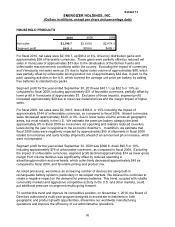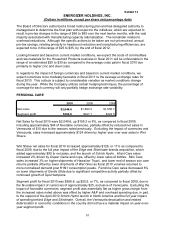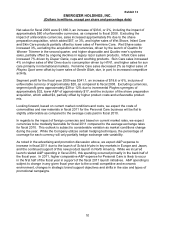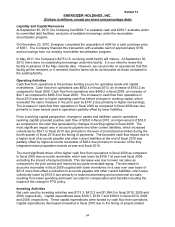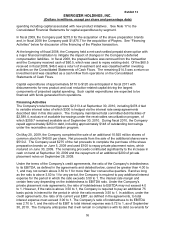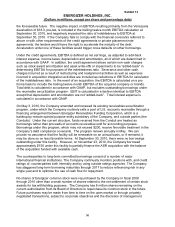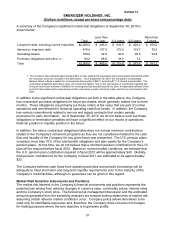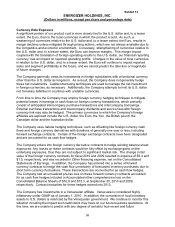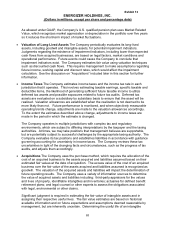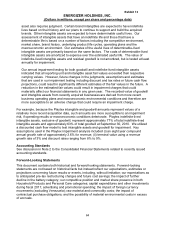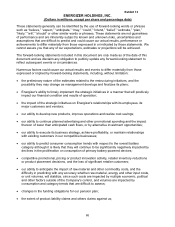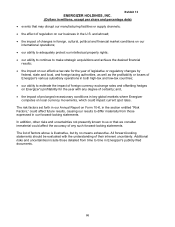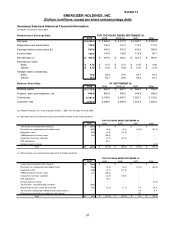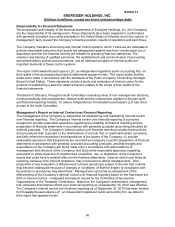Energizer 2010 Annual Report Download - page 68
Download and view the complete annual report
Please find page 68 of the 2010 Energizer annual report below. You can navigate through the pages in the report by either clicking on the pages listed below, or by using the keyword search tool below to find specific information within the annual report.
Exhibit 13
ENERGIZER HOLDINGS, INC.
(Dollars in millions, except per share and percentage data)
58
Currency Rate Exposure
A significant portion of our product cost is more closely tied to the U.S. dollar and, to a lesser
extent, the Euro, than to the local currencies in which the product is sold. As such, a
weakening of currencies relative to the U.S. dollar and, to a lesser extent, the Euro, results in
margin declines unless mitigated through pricing actions, which are not always available due to
the competitive and economic environment. Conversely, strengthening of currencies relative to
the U.S. dollar and, to a lesser extent, the Euro can improve margins. This margin impact
coupled with the translation of foreign operating results to the U.S. dollar, our financial reporting
currency, has an impact on reported operating profits. Changes in the value of local currencies
in relation to the U.S. dollar, and, to a lesser extent, the Euro will continue to impact reported
sales and segment profitability in the future, and we cannot predict the direction or magnitude
of future changes.
The Company generally views its investments in foreign subsidiaries with a functional currency
other than the U.S. dollar as long-term. As a result, the Company does not generally hedge
these net investments. Capital structuring techniques are used to manage the net investment
in foreign currencies, as necessary. Additionally, the Company attempts to limit its U.S. dollar
net monetary liabilities in countries with unstable currencies.
From time to time the Company may employ foreign currency hedging techniques to mitigate
potential losses in earnings or cash flows on foreign currency transactions, which primarily
consist of anticipated intercompany purchase transactions and intercompany borrowings.
External purchase transactions and intercompany dividends and service fees with foreign
currency risk may also be hedged. The primary currencies to which the Company’s foreign
affiliates are exposed include the U.S. dollar, the Euro, the Yen, the British pound, the
Canadian dollar and the Australian dollar.
The Company uses natural hedging techniques, such as offsetting like foreign currency cash
flows and foreign currency derivatives with durations of generally one year or less, including
forward exchange contracts. Certain of the foreign exchange contracts have been designated
and are accounted for as cash flow hedges.
The Company enters into foreign currency derivative contracts to hedge existing balance sheet
exposures. Any losses on these contracts would be fully offset by exchange gains on the
underlying exposures, thus they are not subject to significant market risk. The change in fair
value of the foreign currency contracts for fiscal 2010 and 2009 resulted in expense of $5.4 and
$1.5, respectively, and was recorded in Other financing expense, net on the Consolidated
Statements of Earnings. In addition, the Company has entered into a series of forward
currency contracts to hedge the cash flow uncertainty of forecasted inventory purchases due to
short term currency fluctuations. These transactions are accounted for as cash flow hedges.
The Company had an unrealized pre-tax loss on these forward currency contracts accounted
for as cash flow hedges included in Accumulated other comprehensive loss on the
Consolidated Balance Sheets of $16.8 and $15.3, at September 30, 2010 and 2009,
respectively. Contract maturities for these hedges extend into 2013.
The Company has investments in a Venezuelan affiliate. Venezuela is considered highly
inflationary under GAAP as of January 1, 2010. In addition, the conversion of local monetary
assets to U.S. dollars is restricted by the Venezuelan government. We continue to monitor this
situation including the impact such restrictions may have on our future business operations. At
this time, we are unable to predict with any degree of certainty how recent and future




